Address any questions or comments regarding this newsletter to the individual authors listed after each article or to its editors, Nathan Johanning, 618-939-3434, njohann@illinois.edu or Bronwyn Aly 618-695-6060, baly@illinois.edu. The Illinois Fruit and Vegetable News is available on the web at: http://ipm.illinois.edu/ifvn/. To receive or be removed from email notification of new postings of this newsletter, contact Nathan Johanning or Bronwyn Aly at the phone numbers or email addresses above.
In This Issue:
Upcoming programs (listings for beginning and established growers)
News & Announcements (2022 Illinois Specialty Crop Conference: In-person & virtual hybrid program; Be part of the future of farming, take the Illinois agriculture needs survey; Illinois Pesticide Review; Illinois Stewardship Alliance’s Resilience Fund; Kentucky Department of Agriculture, Kentucky Farm Bureau Federation, University of Kentucky Cooperative Extension team up to support Western Kentucky)
Regional Reports (SuSoCo (Cook County), central Illinois, St. Louis metro east, southwestern Illinois (Waterloo), southern Illinois (Murphysboro), Dixon Springs)
Fruit & Vegetable Production and Pest Management (Weather Update: Dry November Ends a Warm Fall)
Upcoming programs
See the University of Illinois Extension Local Food Systems and Small Farms Team’s website at:
http://web.extension.illinois.edu/smallfarm/ and the calendar of events at http://web.extension.illinois.edu/units/calendar.cfm?UnitID=629.
- 2022 KY Fruit and Vegetable Conference will be held January 2-4, 2022 in Bowling Green, KY. Registration and conference information can be found at https://kyhortcouncil.org/2022-ky-fruit-vegetable-conference/
- 2022 Illinois Specialty Crop Conference, January 5-7, 2022 at the Springfield Crowne Plaza. Attend in-person, view LIVE sessions remotely, or watch workshops at-your-own pace! For more information or to register visit https://www.specialtygrowers.org/iscc2022.
- Great Plains Grower School (Kansas, Missouri, Nebraska and Iowa) will be held January 7-8, 2022 in St. Joseph, MO. Registration and conference information can be found at https://www.greatplainsgrowersconference.org/
- Illiana Vegetable Growers Symposium, Wednesday, January 12, 2022, 8:00 a.m. to 4:00 p.m. Central Time, at Teibel’s Family Restaurant, 1775 US 41, US 30 & US 41, Schererville, Indiana. Registration for 2022 is open! Register online before midnight January 4, 2022. Visit https://cvent.me/ZqPo2w . Or, download the registration form, and mail in, postmarked by Dec. 20, 2021. For more information contact Nikky Witkowski, nikky@purdue.edu, 219-465-3555.
- 2022 University of Illinois Extension Small Farms Winter Webinar Series. This free weekly Zoom series, held on Thursdays from noon-1 pm, covers topics relevant for new and established farmers throughout Illinois. Each week, a topic will be presented that will help you adopt new practices, start growing a new crop, get started in livestock, and find out about impactful University of Illinois research. To register and for more information, please visit go.illinois.edu/smfarmswebinarseries
-
January 20, 2022 Practical Agroforesty Katie Adams, Sven Pihl,
& Eric Wolske
January 27, 2022 Regenerative Agriculture Kacie Athey
February 3, 2022 Vining Through Pumpkin Production Nathan Johanning
February 10, 2022 2022 Illinois Home to Market Law Mary Liz Wright
February 17, 2022 Pawpaws: Our Native ‘Tropical’ Fruit Doug Gucker
February 24, 2022 High Tunnel Winter Greens Research
from Dixon Springs Bronwyn Aly
March 3, 2022 Introduction to Vermicomposting Crystal Stevens
March 10, 2022 Mushroom Production Michael Hatfield
March 17, 2022 Getting Started with Backyard Swine Katie Bell
March 24, 2022 Growing Great Grapes Grant McCarty - 2022 North American Raspberry & Blackberry Conference, February 21-24, 2022, DoubleTree by Hilton Washington DC North/Gaithersburg, 620 Perry Parkway, Gaithersburg, MD 20877. For more details about this hybrid (in-person and virtual) conference, visit https://www.raspberryblackberry.com/2022-north-american-raspberry-blackberry-conference/
- 33rd Annual MOSES Organic Farming Conference, Feb. 24-26, 2021, in La Crosse, Wis. The event brings together farmers, researchers, and agriculture professionals to learn the latest organic production practices and build a supportive community of resilient organic, sustainable, and regenerative farms. See mosesorganic.org/conference for registration information, workshop descriptions, and more details. To request more information about the conference or a mail-in registration form, call 888-90-MOSES.
News & Announcements
2022 Illinois Specialty Crop Conference: In-person & virtual hybrid program!
The 2022 Illinois Specialty Crop Conference (ISCC) & Trade Show is moving to a hybrid format offering attendees the opportunity to attend in person, view LIVE sessions remotely, or both! The conference is aimed at meeting the needs of agritourism businesses, irrigation issues, pollinators, cut flower growers, organics, and producers of vegetable, herb, and fruit crops in Illinois and surrounding states.
Registration Rates & Details
All pre-conference and virtual conference registration must be received by December 31, 2021. No virtual registration will be available after this date. All other registration must be done at the conference and meals cannot be guaranteed.
JOIN ISGA TODAY AND SAVE ON
THIS YEAR’S CONFERENCE REGISTRATION!
IN-PERSON PRE-REGISTRATION PRICING (REGISTER BEFORE DEC. 31)
Member............................$125 / Non-Member....................$185
VIRTUAL REGISTRATION PRICING (VIRTUAL REGISTRATION CLOSES DEC. 31)
Member............................$100 / Non-Member....................$160
Register Online
Be part of the future of farming, take the Illinois agriculture needs survey
URBANA, Ill. – Farming is changing. It’s hard for everyone, small farmers and commercial producers alike, to keep up with the latest research, changing climates, emerging pesticide resistance, new crop varieties all while trying to stay healthy and productive.
For more than 100 years, University of Illinois Extension has worked with agricultural communities to empower them to meet challenges with confidence. Now, you can be part of the future of farming in Illinois by taking a few minutes to share your thoughts with Extension researchers online at go.illinois.edu/AgNeeds.
“This survey will help us get an accurate picture of what our agriculture stakeholders’ needs are,” says Katie Bell, Illinois Extension local foods small farms educator.
Extension agriculture educators regularly ask those working in the agricultural industry about their concerns and use the feedback to develop trainings for the public on new and emerging topics and develop research projects that address gaps in current understanding of crop sciences.
“Knowing what our farm communities are thinking about helps us prioritize what research projects our scientists can focus their efforts on so we can then share accurate information that our stakeholders can trust,” Bell says.
The survey is anonymous and open to all Illinois producers, and agriculture industry professionals now through March 2022. It will take 10 to 20 minutes to complete.
For more information about the survey, contact Katie Bell at (618) 687-1727 or klbell@illinois.edu.
Illinois Pesticide Review
The Illinois Pesticide Review is a hidden gem of a resource offered by University of Illinois and we wanted to share its availability with our subscribers. An example of information published in the Illinois Pesticide Review is this article, Pesticide Use in Greenhouses: Some Quick Questions and Answers.
This bimonthly newsletter is written by Pesticide Safety Education Program specialists to address pesticide safety issues, regulatory information, and changes in pesticide registration and label status. Each issue contains at least one in-depth article addressing current pesticide issues or pesticide-related activities. The newsletter is available on Pesticide Safety Education website or you can Subscribe here.
Illinois Stewardship Alliance’s Resilience Fund
Are you a local food producer looking to scale and adapt your business?
If so, we are excited to share with you the return of the Illinois Stewardship Alliance’s Resilience Fund.
With financial support from the Chicago Region Food System Fund, The Resilience Fund helps Illinois local food producers invest in critical infrastructure to scale and adapt their businesses to improve the capacity and resiliency of the local food system.
Last year, the Resilience Fund awarded 27 local farms a total of $225,000 in grants. In all, 80 local food farmers applied for over $1 million in support, indicating an ongoing and unmet need for local food infrastructure development.
In the coming months, $175,000 will be awarded to local food producers for investment in critical infrastructure to increase the capacity and resiliency of our local food system. Farms and farm collaborations will have the opportunity to apply for grants of up to $10,000.
The application is now open. The deadline to apply is February 15, 2022. Decisions are anticipated by April 1, 2022.
The application as well as additional information regarding eligibility, funding priorities, previously awarded projects, etc. can be found at www.ilstewards.org/resilience
If you have any questions, please contact Garrett Peterson at 608-354-9280 or garrett@ilstewards.org.
Apply today at www.ilstewards.org/resilience
Kentucky Department of Agriculture, Kentucky Farm Bureau Federation, University of Kentucky Cooperative Extension team up to support Western Kentucky
As a neighbor, especially to many in southern Illinois, we wanted to share with our readers some information about the relief efforts to support our fellow farms affected by the recent, devastating tornadoes in Western Kentucky.
- Nathan & Bronwyn
Two ways to support farmers, ag-businesses in Western Kentucky
FRANKFORT (Dec. 13, 2021) –The Kentucky Department of Agriculture (KDA), the Kentucky Farm Bureau Federation, and the University of Kentucky College of Agriculture, Food and Environment Cooperative Extension are joining forces to raise funds and resources for agricultural-related recovery efforts for farmers affected by the weekend’s devastating storm event.
“West and western Kentucky agriculture did not escape the historic and devastating tornadoes that struck the region this weekend,” Kentucky Commissioner of Agriculture Ryan Quarles said. “We’ve seen lives lost, grain bins leveled, and livestock and poultry barns demolished. Our farmers need funds and resources to maintain operations and rebuild. I thank Kentucky Farm Bureau and the University of Kentucky Cooperative Extension for stepping up to help Kentuckians in need.”
“The heartbreaking devastation from this past weekend’s tornado outbreak is overwhelming for so many families and communities throughout the commonwealth. Never have so many Kentuckians experienced such monumental loss. Many lost everything,” said Kentucky Farm Bureau President Mark Haney. “Rural communities affected by these devastating storms need our help. I am confident this fund will be successful helping Kentucky farm families get back to the important business of producing the food, fiber, and fuel upon which our nation relies.”
“UK Cooperative Extension has always been both in and of the counties it serves. Our agents and staff are leaders and neighbors in their communities and stand ready to serve the West Kentucky region as we have historically done in the wake of tragedy,” said Nancy Cox, Vice President for Land-grant Engagement and Dean of the UK College of Agriculture, Food and Environment. “We appreciate the leadership of Kentucky Farm Bureau, the Kentucky Department of Agriculture and our agents on the ground — together we will continue serving Kentucky.”
The Kentucky Agriculture Relief Fund
The Kentucky Agriculture Relief Fund is a cash donation portal managed by the Kentucky Farm Bureau Education Foundation. Funds collected will be administered through a grant process. The donations will be used to support farmers and agribusinesses in the affected areas.
Donations can be made to the Kentucky Agriculture Relief Fund at gofundme.com/KyAgReliefFund.
Kentucky Ag Disaster Donations
The Kentucky Department of Agriculture and the University of Kentucky College of Agriculture, Food and Environment’s Cooperative Extension Service are teaming up to coordinate an operation to identify the needs and supplies for individual farming operations in the impacted area.
Individuals in impacted areas should contact their county extension office, which will collect a list of needs from producers for their operation and provide that information to the KDA. The Department will then coordinate with farm organizations in the commonwealth and work to match the requested need with the donor of the item. This can include immediate needs such as hay or feed to longer-term items such as fencing material.
-Kentucky Department of Agriculture
Regional Reports
From the South Suburban Cook Urban Agriculture Demonstration and Research site (SoSuCo) in Matteson, IL (Cook County)…
The unexpectedly warm temperatures and sunshine have been a boon for winter crops at SoSuCo during the early part of this winter growing season. Typically growth slows to a near standstill when day length has dropped below the 10-hour threshold, which is around November 10th here at 41.5oN latitude. However, noticeably more substantial growth has occurred in our high tunnel, helped by our ability to keep the inner low tunnel layer off the crops due to the mild night temperatures. We have yet to dip below 18-19 F in our tunnels, with outside night lows in the low teens to high single digits only occurring once so far. This lack of an additional inner layer means more photosynthetically active radiation (PAR) is getting into the crop canopy for albeit slow but still occurring photosynthesis and growth. In conjunction with the Sustainable Student Farm on the main campus, we are conducting an informal planting date trial with Spinach varieties like Space, Auroch, and Red Tabby. The goal is to confirm the first appreciable harvest dates for spinach plantings after the typical “last winter spinach dates.” These specific last dates vary by latitude, but for us usually occur during the first or second week of October.
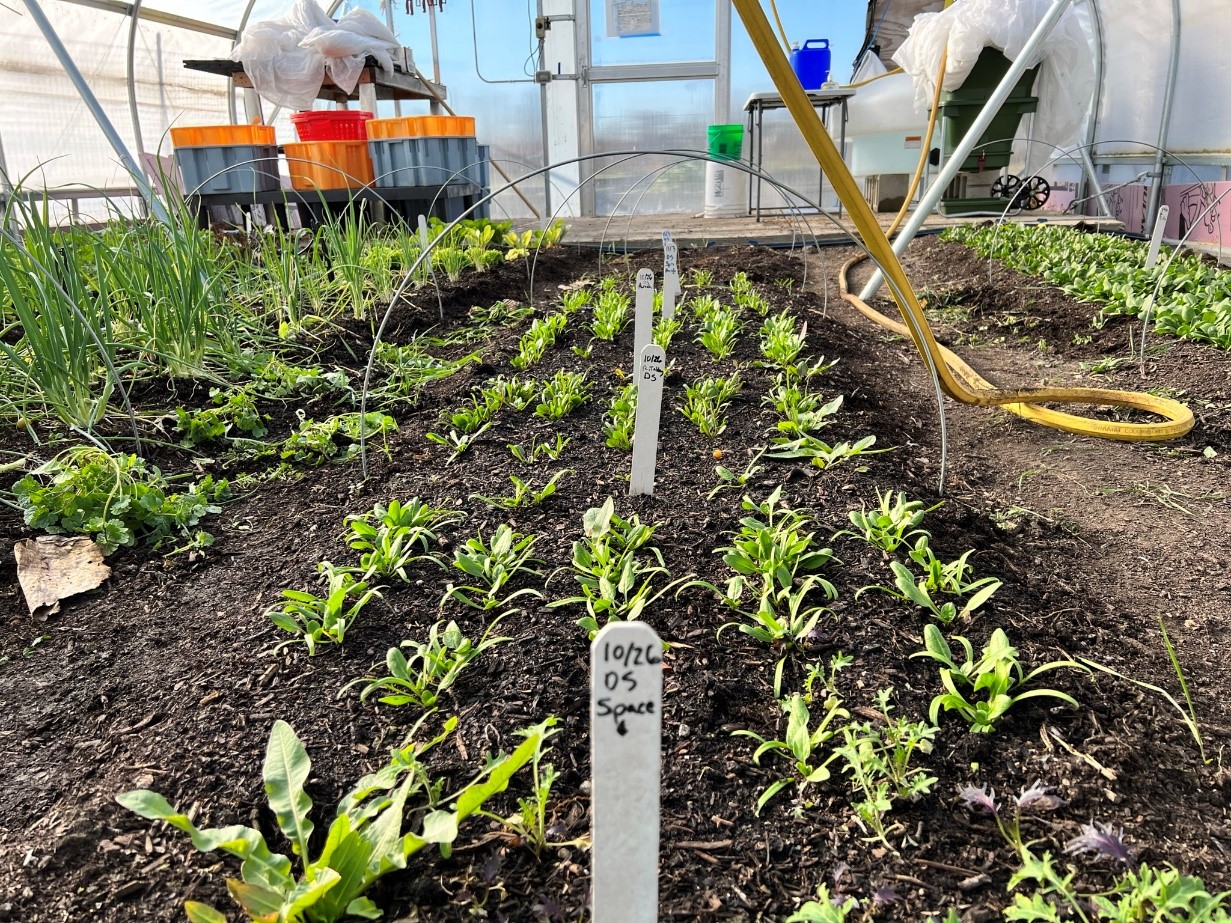
In the above picture (taken December 3rd, photo credit Zack Grant), you see late spinach direct-seeded planting dates from 10/26 through 11/3. The idea of the observational trial will be to track the number of days from seeding until the plantings have enough growth for an appreciable harvest. This planting data is needed for high tunnel
growers to maintain a more consistent supply of spinach in late winter from these fall planting dates. Since these planting dates are daylength and therefore latitudinally dependent, it is critical to collect this data from research sites throughout the length of the state.
Another management note of significance from SoSuCo this winter relates to ventilation. While it may seem counterintuitive to have active ventilation during the winter months, it is critical for disease management and crop quality. We have noticed a significantly drier and, therefore, less diseased prone high tunnel so far when we set our automatic ventilation setpoints lower than during the shoulder or regular season. This setpoint change amounts to the end wall vent louvers initiating at around 50F and the powered shutter fan kicking on just above 60F, while the HAF fans remain on constantly. Since initiating, this management shift has noticeably reduced our vapor pressure deficit in the tunnel.
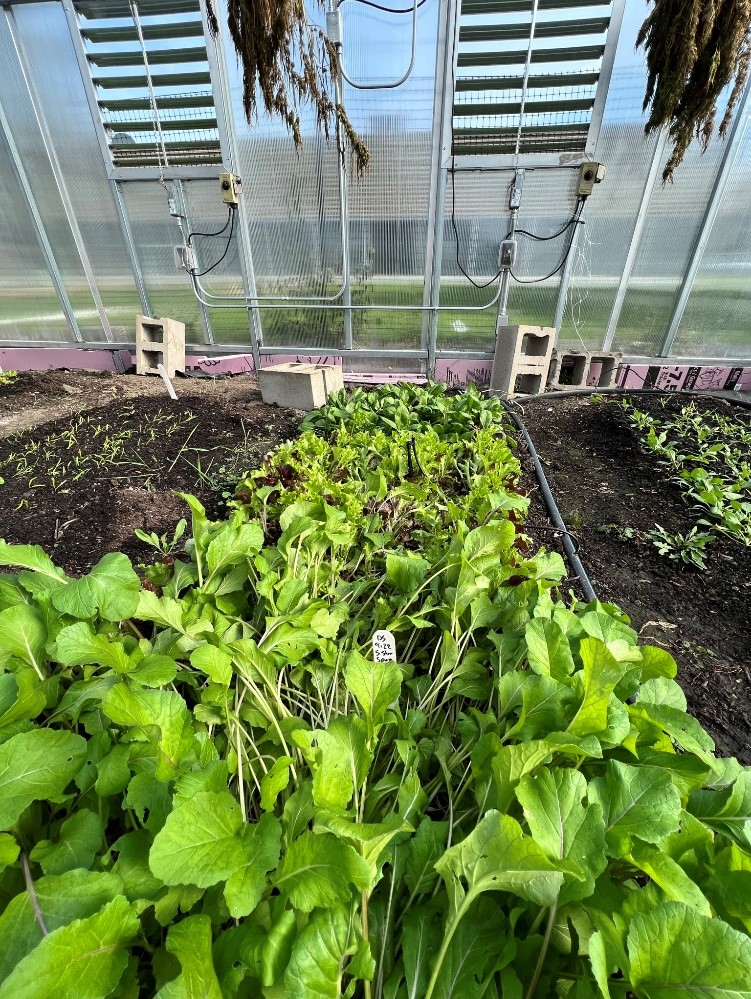
In the above picture (photo credit: Zack Grant), you can see two of the three end wall vent louvers, each set to distinctive set points from 50F to 60F in order to lower the vapor-pressure deficit and therefore lower the incidence of plant disease and rot.
Zachary Grant (708-449-4320; zgrant2@illinois.edu)
From central Illinois (Bloomington)… It’s been a little bit wetter than usual this fall in central Illinois, and without a doubt warmer than it has ever been in December, in my lifetime. The good news is that my cover crops love it.
At the Unity Community Center Production and Demonstration Garden, I planted a popular seed company’s fall green manure mix at the end of summer, along with other cover crop seed I needed to use that I thought would grow well with the green manure mix. Planting date for the cover crops was on August 20th on one half of the garden area, and the same mix on the other half was planted on September 1st. For the readers who don’t remember what happened here this season, the garden was separated into halves in March, about 1300 ft2 each. One half was designated as needing a rest year (i.e., soil-building year) and was no-till cover cropped in an oats/field pea/Dutch white clover in spring, then Japanese millet/cowpea mix for summer. The other half of the garden had slightly better drainage so we decided it would be our production garden area for the year. We produced about 1100 lbs of warm season vegetables off that area and pulled all the vegetable residue and cages out in late August.
So, fast-forward to August/September, and I decided the whole thing needed a good cover to absorb all the fall sun, hold soil, add fertility, break up compaction, fight the weeds and more over the winter. I went with a mix of 11 different species. Don’t ask me why, my Spidey-senses were tingling. I think what’s happening is that I am learning to sense what the soil wants me to feed it, after almost a full year of cover-cropping the same piece of ground and visiting it so often, digging in it, smelling the soil, that kind of thing.
Some people look at me funny when I advocate for cover crop mixes. Let me ask the reader something. Do you like eating the same thing every single day, day-in, day-out? I don’t either. So, I’m guessing that the soil microbiological community that feeds on the root exudates of the cover crops will really appreciate the smorgasbord of species I planted. These include:
- Oats
- Field pea – two types
- Hairy vetch
- Ryegrass
- Winter rye
- Crimson clover
- Dutch white clover
- Purple top turnips
- Tillage radish
- Oilseed radish
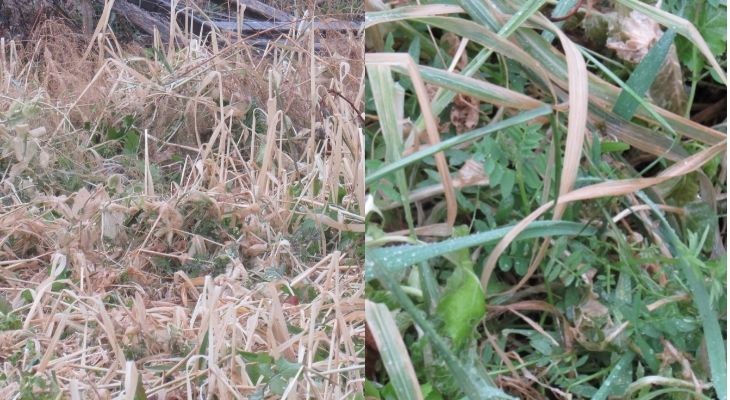
The plan for the garden next year is that we are going to switch the management plan for the two sides. So the side that put out 1300lbs of vegetables (which was super-compacted) will now get a no-till soil-building year (rest year no more). The side that got 3 cover crops in a row will experience regrowth from several species in spring, get mowed back super-low in April sometime, tarped with silage tarp for 3 weeks, and planted with warm season vegetable transplants in late May/early June. I can’t wait to see how the plants grow in that soil – once grey and compacted, now loamy and a good deal darker in color; stay tuned to see how it turns out!

Nick Frillman (309-663-8306; frillma2@illinois.edu)
From St. Louis metro east… On December 2, 2021, the FDA released proposed changes to Food Safety Modernization Act (FSMA) rule to enhance safety of agricultural water used on produce. For a summary, go to https://www.fda.gov/news-events/press-announcements/fda-proposes-changes-food-safety-modernization-act-rule-enhance-safety-agricultural-water-used. The comment period is now open through April 5, 2022 to submit comments on the new proposed rule within FSMA for agricultural water used on produce https://www.federalregister.gov/documents/2021/12/06/2021-26127/standards-for-the-growing-harvesting-packing-and-holding-of-produce-for-human-consumption-relating.
The Great Lakes, Fruit, Vegetable and Farm Market Expo was held in person December 7-9 in Grand Rapids, MI. As expected attendance was down due to COVID-19 concerns, but still at a level to give hope for the future of face-to-face educational programs and trade shows. Of interest was the discussion on climate change and its impact on specialty crop production. To summarize, the pathologist and entomologist are expecting pest pressure to increase. No good news there. Chilling hours are expected to increase for northern tier states, including northern Illinois. This may seem counter intuitive at first, but chilling hours generally accumulate in the temperature range of 32° - 47°F. As temperatures warm with climate change, the northern latitudes are predicted to accumulate more hours falling in this range than before, meaning plants will meet their chilling requirement sooner, predisposing them to an increased risk of frost and freeze injury. The rest of Illinois is not expected to see much change in chilling hours accumulation, but everything south of Illinois is expected to lose chilling hours. For the northern areas, research has already begun on possible hormone treatments to “keep’ the plants dormant under increasing chilling hours.
Just as a reminder for those attending upcoming educational programs in Illinois like the Illinois Specialty Crops Conference January 5-7, the state is as of this writing under a mask mandate where all individuals in Illinois who are age two or over and able to medically tolerate a face covering (a mask or cloth face covering) shall be required to cover their nose and mouth with a face covering when in an indoor public place. For those not comfortable attending the Specialty Crops Conference in person, a hybrid format is available for all registrants. All presentations will be recorded and made available online for all registrants, as well as selected presentations presented live via Zoom. If you haven’t already registered, you can still pre-register before Dec 31 at https://www.specialtygrowers.org/iscc2022
Check your IL Pesticide Applicators License to make sure you know when it expires! If your license expires at the end of this year, testing with IDOA is available in person or proctored online. The UI Extension Pesticide Education Program (PSEP) is available for the most common categories as a self-paced online training course. Testing is separate from the online training, so you must sign up individually for testing. The one-stop web page to sign up for training and/or testing is https://extension.illinois.edu/psep/training-and-testing In-person testing-only sites are filling up fast, so don’t delay.
Elizabeth Wahle (618-344-4230; wahle@illinois.edu)
From southwestern Illinois (Waterloo)… Our area has had reasonable warm for this time of year but we have had some cold spells as well. We have had a few warm days around 70°, but those have been very short lived mostly we have been in the 40s & 50s for highs with some days above or below. We have had some cold nights with a few nights down as low as 16° I saw early one morning, but most had been in the 20s at the coldest. Overall, we have had quite a few sunny days so even some of the colder temperatures can be moderated by the sunshine. Until the last few days we have been reasonably dry. Here in Waterloo we have missed rain from most of the fronts passing our way in the last month or more only getting maybe 0.05 to 0.2” at any one time. From Wednesday (12/15) to midday today (12/17) we have gotten an inch of rain which is the most at anyone period we have had in quite some time. We are to stay around 40s to 50 for the forecasted future. The weekend is supposed to have some lows around 20° but then lows are supposed to maintain around or above freezing for right now.
Out in the field things are fairly slow but mostly dry field conditions have been good to get some field preparation and off-season work done. Some larger orchards have started some pruning and orchard clean up especially on apples. Cover crop have been doing well with the modest temperatures. We have oats and crimson clover planted (planted late August) for no-till field corn next year at home on our farm. The oats on this part of the field pictured was a little thin but the clover has done well. The oats by now is starting to show some yellowing from the frost and few nights down to 20°, but is still alive. You may be able to see in the background the terrain is very rolling so this is an awesome cover to have going into winter. Shortly after the last issue, I did finally get to harvest my first cauliflower and it has been well worth the wait! It is very tender and sweet which is what I would expect. I have read that heat can sometimes delay curd initiation and given the heat we had, really through almost the end of October, I wonder if that is what delayed maturity. Although if you are planting for a certain harvest date this can be challenging, the plant is adapting to “yield” under the conditions it will perform the best in rather than initiating curds during a time that will lead to a poor quality. I have actually pulled the row cover off for a few periods of warm weather but other than that I have kept it covered in the last few weeks. I also harvested quite a few side shoots from the broccoli many of which were still very decent size. At home I have a small high tunnel with some greens and sweet turnips just enough to enjoy at home. They were direct-seeded 10/5 and I haven’t harvested anything yet but am getting close. At this point my goal is to have fresh farm vegetables for Christmas and into next year!
We are certainly thinking of many who where hit by tornadoes the night of Friday, December 10, especially in Kentucky which has been the hardest it. I work with various colleagues at the University of Kentucky Research Center at Princeton which was completely destroyed among many other places.
Here is too a Merry Christmas and looking forward to 2022! Hope to see some of you at the Illinois Specialty Crops Conference at the Pumpkin Workshop!
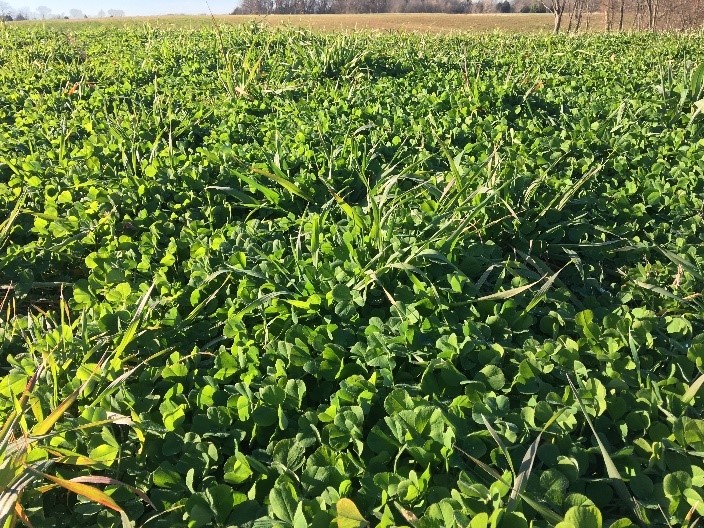
Fall cover crop growth on oats and crimson clover (left). December cauliflower harvest of in fall planting (right). Photos: N. Johanning
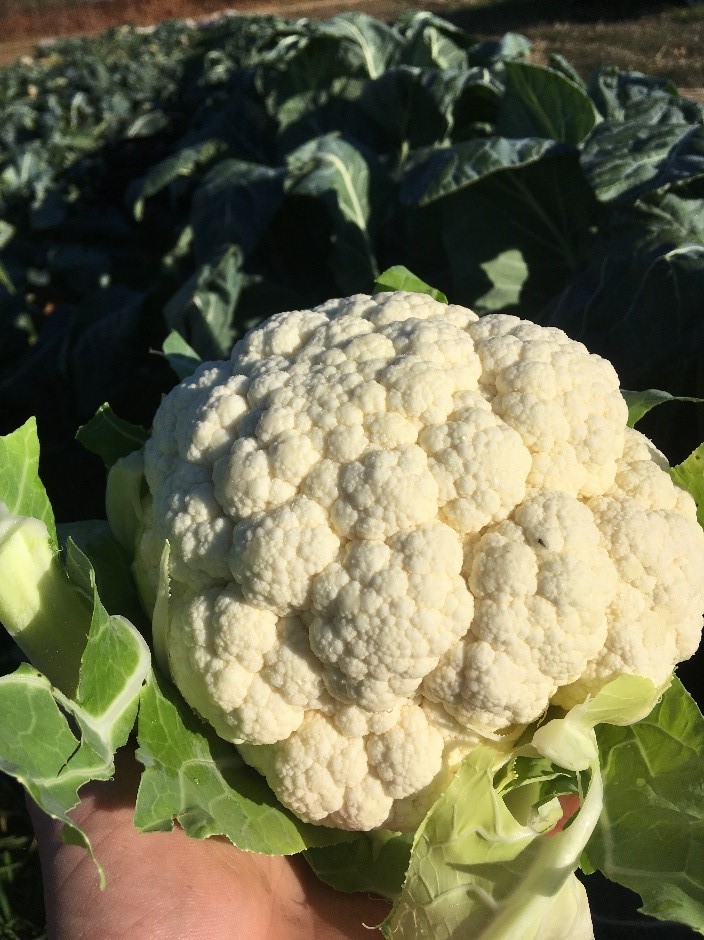
Nathan Johanning (618-939-3434; njohann@illinois.edu)
From southern Illinois (Murphysboro)… Here at the Jackson Co. high tunnel most of the carrot varieties are almost ready to harvest. The tatsoi and kale have been harvested several times, and the radishes were harvested at the end of November. In the tunnel we also have broccoli, cauliflower, and bulbing fennel.

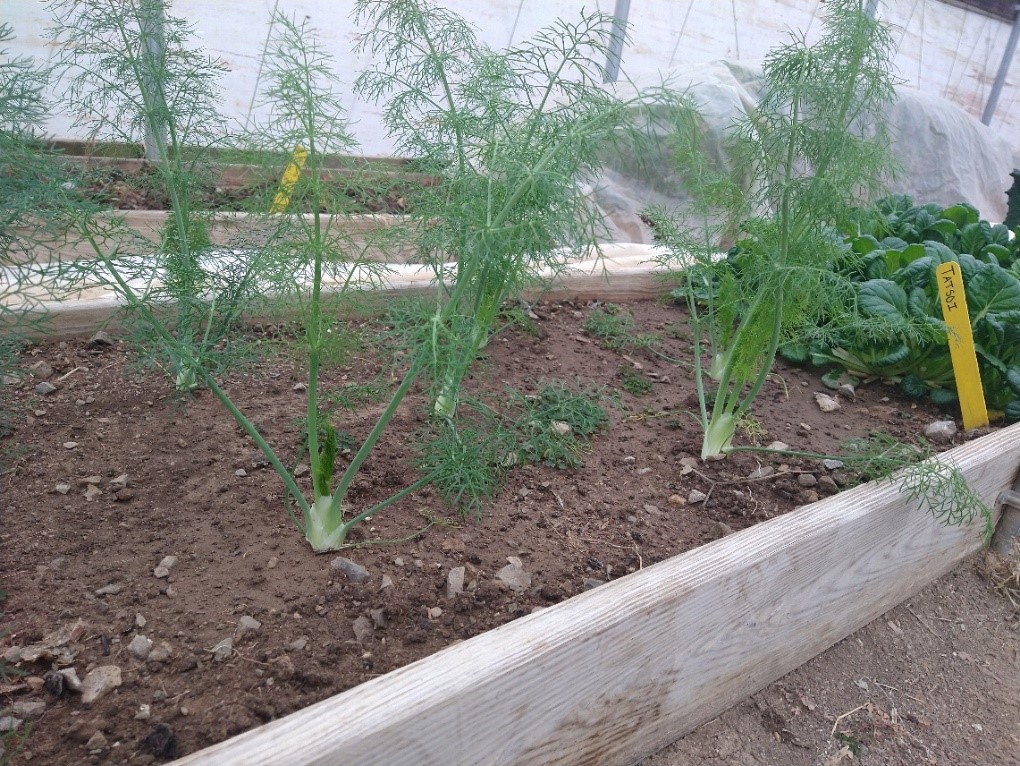
Carrots (left) and bulbing fennel (right) in the High Tunnel in Jackson Co. Photos: K. Bell.
As we approach the holiday season, we are still experiencing uncharacteristically warm temperatures. These unusual temperatures have led to strong winds and storms across Illinois. Friday December 10, parts of the Midwest were under severe thunderstorm and tornado warnings. Here at the Jackson County office we had very little damage, but the strong winds did “relocate” our small, high tunnel that was over a raised bed. Other parts of Illinois and surrounding states were not so lucky, suffering damage ranging from down limbs to extensive structural damages. As people continue to recover and clean-up from the storms, we send our thoughts and well wishes to them.
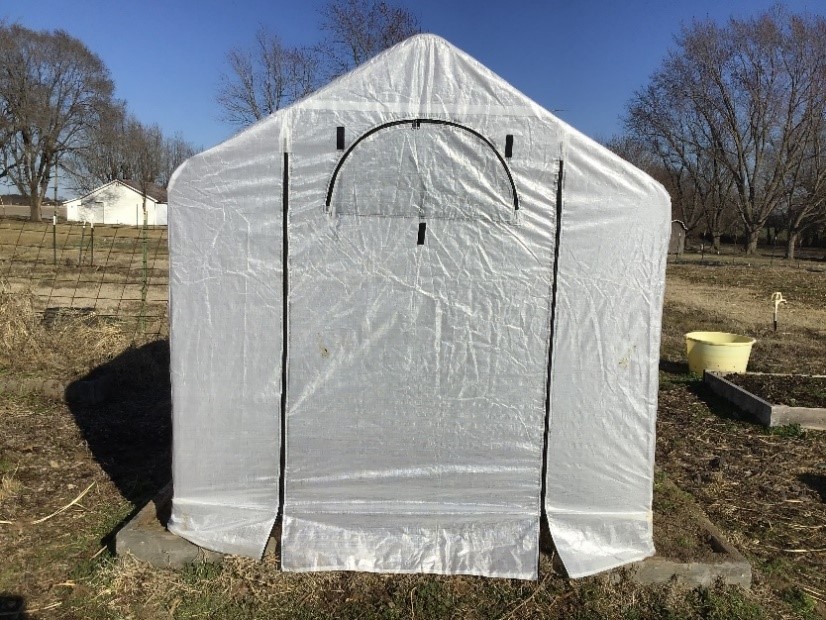
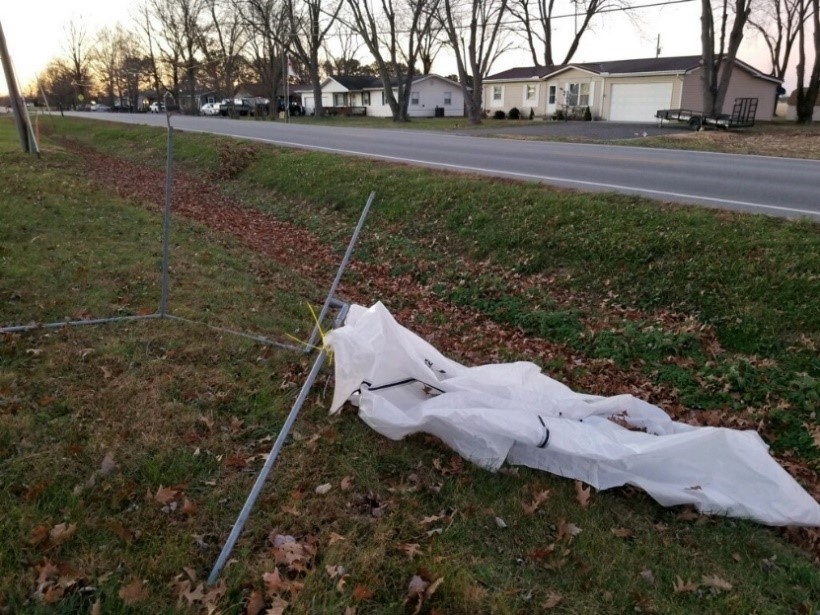
Even though the immediate danger of the tornado or severe storm has past, there are still risks associated with cleaning up in the days and weeks after a strong wind event. After a storm your first instinct might be to rush in and immediately start cleaning up debris, however it is important to take a moment to develop a plan and take stock of potential hazards. Farming sheds can contain pesticides, fertilizers, and fuel, that can be dangerous to breath or handle without proper protection. Another common hazard on farms is damaged electrical lines or water lines; make sure that you know where electrical and water shut offs are located and double check before entering areas for cleanup. Be aware when using ladders, chainsaws, and machinery to remove debris. This may seem like a given, but after you have been working for hours or days it can be easy for accidents to happen. For more information on responding to tornado damage check out the CDC’s article Tornado Cleanup and Response. Cleanup on farms after a natural disaster can be made safer by having a good safety plan that includes information about on-farm chemicals, electrical and water shut offs, accurate livestock counts, and emergency contact numbers.
As always have a great holiday season and see you next year!
Katie Bell (618-687-1727; klbell@illinois.edu)
From Dixon Springs Ag Center…During the first half of December, temperatures have been jumping all over the place, ranging from 70 degrees as a high to 22 degrees as a low. We have received some rain and the fields seem to be holding an adequate amount of moisture. With no crops growing in the high tunnels this winter, there doesn’t seem much to give an update on. A thunderstorm that rolled through the first week of December had enough wind to rip the plastic on one of the high tunnels, requiring complete removal. While we will have to reskin this tunnel before we plant in late March/early April, having the beds within this tunnel exposed to natural rain events for the next few months will help to leach out some of the salt buildup of fertilizers applied during the summer.
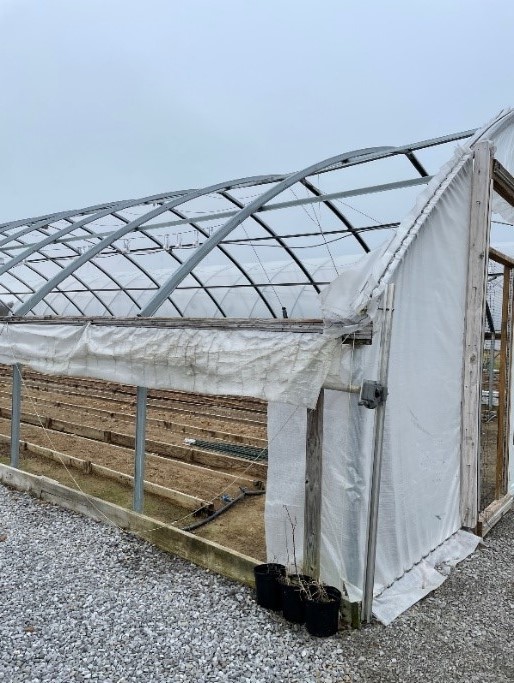
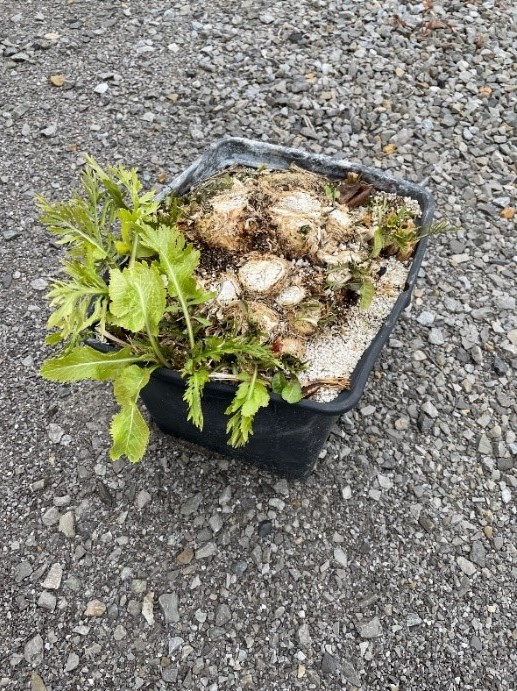
Top left: High tunnel with plastic removed due to wind damage; top right: hydroponic horseradish grown throughout the summer at DSAC; bottom left: interesting root growth from the hydroponic horseradish plant. Photos by B. Aly.
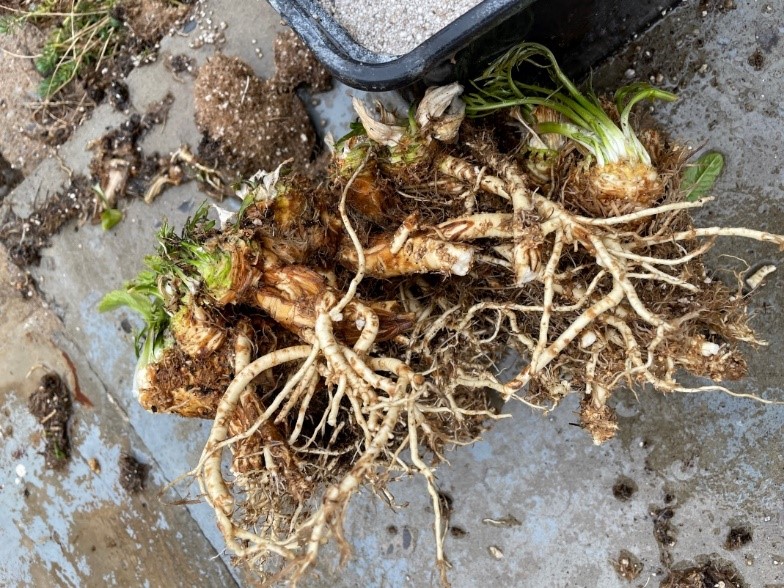
Over the summer, we grew out a horseradish root hydroponically. There was quite a bit of top growth on the plant and I was curious to see how the root would perform in the perlite substrate confined to the dutch bucket. The pictures above show the crown of the plant after the leaves were removed and then the roots themselves. The bucket contained a lot of tiny, fibrous roots along with the bigger ones seen in the photo. The roots did not size in diameter much at all, with the largest root piece being about 1 inch across. The roots were all very clean and really white inside. And yes, there was a good amount of heat to them as well!
I want to wish everyone a happy and blessed holiday season and I look forward to seeing everyone in Springfield in January!
Bronwyn Aly (618-382-2662; baly@illinois.edu)
Fruit & Vegetable Production and Pest Management
Weather Update: Dry November Ends a Warm Fall
November in Illinois was slightly cooler and much drier than normal. Despite the cooler weather, the Fall season was much warmer than normal statewide.
November temperatures averaged 41.0°F, 1.2° below the 1991-2020 normal for November. November average temperatures ranged from the high 30s in northern Illinois to the low 40s in southern Illinois, between 1 and 4 degrees below the 1991-2020 normal. Several stations saw daily high temperatures in the 70s in early November, including a 75-degree high in Randolph County. Meanwhile, several stations in northern and central Illinois reached nighttime minimum temperatures well below 20 degrees, including 10-degree lows in Knox and Warren Counties.
Mild temperatures in November did not break any local daily high maximum or high minimum temperature records in Illinois; however, the daily low minimum temperature records on November 4th and 5th were broken in Casey in Cumberland County.
Fall temperatures (September–November) was overall warmer than normal across most of Illinois. Seasonal temperatures averaged 56.9°F, 2.3° above the 1991-2020 normal, ranging from the low 50s in northern Illinois to the high 50s in central and southern Illinois. Fall temperatures were 1 to 4 degrees above normal in northern and central Illinois, and within 1 degree of normal in southern Illinois.
November precipitation statewide was 0.87 inches, 2.21 inches below the long-term statewide average. The entire state was drier than normal, as November totals ranged from less than a quarter of an inch in northwest Illinois to just over 2 inches in southeast Illinois. Last month was the second driest November on record in Rockford (0.45 inches), and the third direst on record in St. Louis (0.35 inches). The persistently wet conditions resulted in monthly totals ranging from 3.5 inches in southwest and far southeast Illinois to over 9 inches in parts of north-central Illinois. While southern Illinois was 1 to 3 inches wetter than normal last month, central and northern Illinois were closer to 3 to 6 inches wetter than normal. It was the second wettest October on record in Peoria and Quincy and the fifth wettest in Springfield.
Fall precipitation averaged 9.22 inches statewide, 0.47 inches below average. Seasonal totals were highest in east central Illinois, ranging from 10 to 14 inches. Meanwhile, northern and southwest Illinois were the dry spots in Fall, with totals between 6 and 8 inches. The very wet October and very dry November offset, resulting in a fall season that was just slightly drier than normal.
Snow has been hard to come by so far this season. Only the northern third of the state saw snowfall in November, and totals ranged from just over a quarter of an inch in northwest Illinois to less than a tenth of an inch in northeast and central Illinois. November total snowfall was between 0.5 inch and 2 inches below normal in the northern half of the state.
Drought: The dry conditions added to existing precipitation deficits in northern Illinois, and in response we did not see much change in the U.S. Drought Monitor this past month. Most areas between Whiteside County in northwest Illinois and Lake County in northeast Illinois remain in moderate to severe drought as year-to-date precipitation deficits of 6 to 12 inches remain. January 1 through November 30 is the second driest on record in Rockford, greater only than 2012. The dryness in southwest Illinois was noted as the Drought Monitor introduced abnormally dry conditions across much of the St. Louis Metro East area, from Calhoun to Monroe Counties.
Winter Outlook: After a very warm and wild start to December, outlooks are showing better chances of more seasonable conditions in the latter half of the month. Continuing to follow a typical La Niña pattern, the winter season outlooks show the highest odds of a warmer and wetter than normal winter across the state.
Trent Ford, Illinois State Climatologist (217-244-1330; twford@illinois.edu)
Less Seriously
The Aly family...making holiday memories and torturing our pets for decades! Ugly Christmas sweaters and holiday head gear aren’t just for humans. We wish everyone a happy and blessed holiday season!
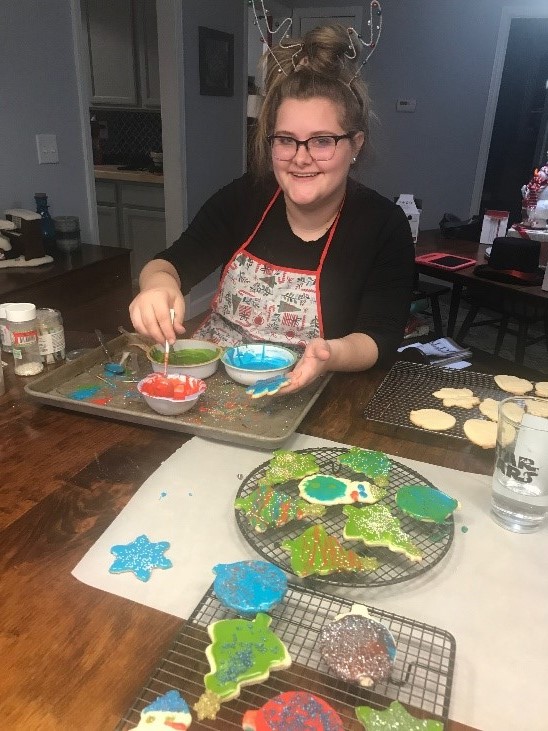


Photos by B. Aly
University of Illinois Extension Specialists in Fruit and Vegetable Production & Pest Management
Extension Educators – Local Food Systems and Small Farms |
||
Bronwyn Aly, Gallatin, Hamilton, Hardin, Pope, Saline, and White counties |
618-382-2662 |
|
Katie Bell, Franklin, Jackson, Perry, Randolph, & Williamson counties |
618-687-1727 |
|
Sarah Farley, Lake & McHenry counties |
847-223-8627 |
|
Nick Frillman, Woodford, Livingston, & McLean counties |
309-663-8306 |
|
Laurie George, Bond, Clinton, Jefferson, Marion, & Washington counties |
618-548-1446 |
|
Zachary Grant, Cook County | 708-679-6889 | |
Doug Gucker, DeWitt, Macon, and Piatt counties |
217-877-6042 |
|
Erin Harper, Champaign, Ford, Iroquois, and Vermillion counties |
217-333-7672 |
|
Grace Margherio, Jackie Joyner-Kersee Center, St. Clair County |
217-244-3547 |
|
Grant McCarty, Jo Daviess, Stephenson, and Winnebago counties |
815-235-4125 |
|
Katie Parker, Adams, Brown, Hancock, Pike and Schuyler counties |
217-223-8380 |
|
Kathryn Pereira, Cook County |
773-233-2900 |
|
James Theuri, Grundy, Kankakee, and Will counties |
815-933-8337 |
|
Extension Educators – Horticulture |
||
Chris Enroth, Henderson, Knox, McDonough, and Warren counties |
309-837-3939 |
|
Richard Hentschel, DuPage, Kane, and Kendall counties |
630-584-6166 |
|
Andrew Holsinger, Christian, Jersey, Macoupin, & Montgomery counties |
217-532-3941 |
|
Extension Educators - Commercial Agriculture |
||
Elizabeth Wahle, Fruit & Vegetable Production |
618-344-4230 |
|
Nathan Johanning, Madison, Monroe & St. Clair counties |
618-939-3434 |
|
Campus-based Extension Specialists |
||
Kacie Athey, Entomology |
217-244-9916 |
|
Mohammad Babadoost, Plant Pathology |
217-333-1523 |
|